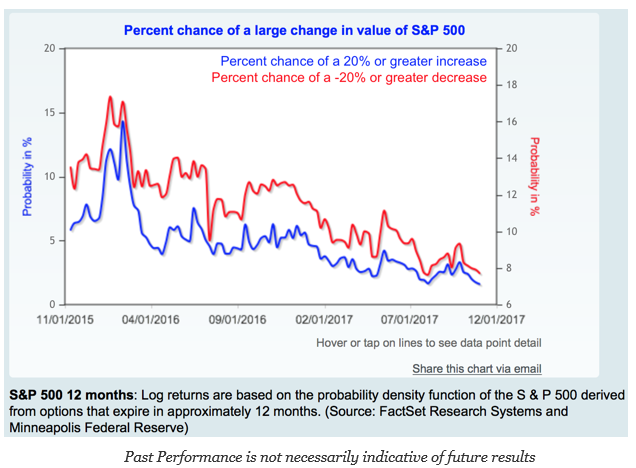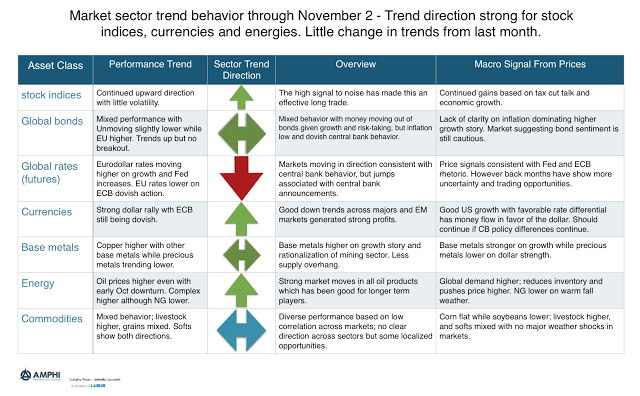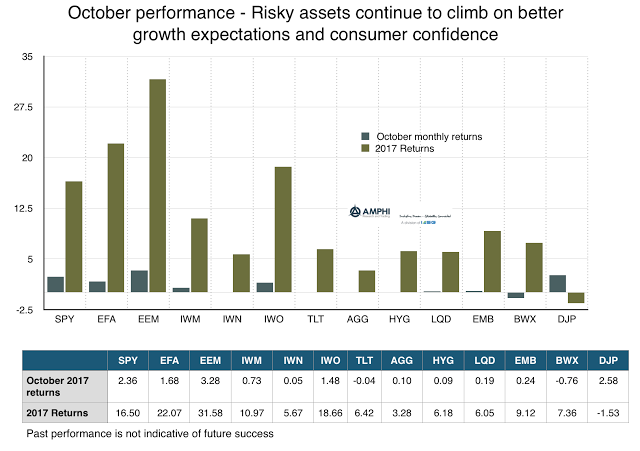Category: Uncategorized

The Upside-Downside Risk Embedded in Options –Lower, But Less Balanced Than Earlier in the Year
From the Minneapolis Fed we have market-based probabilities of a large up or down market move embedded in 12-month options. This is a good market-based view of a large up or down stock market move.

How Many Biases Dragged Down Your Performance Last Month?
The behavioral finance revolution has been well noted by both academics and practitioners. Multiple Nobel Prizes have gone to economists who have studied in this area, yet investment decision-makers still make the same behavioral mistakes. We have noted our biases but often we have not changed our behavior. Perhaps it is too ingrained, but good has to be reinforced.

Trend Continuation in Currencies, Energy, and Equities Will Be Good For Managed Futures
You could call it the second reflation trade. Based on economic data trends which suggest stronger global growth coupled with tax reform/cut talk, we are seeing major sectors show increasing trends and opportunities. The good October trends seem to be carrying over to November. The reflation trades has driven stock indices, energy, and base metals prices higher. The differential between monetary policy in the US and the rest of the world also suggests dollar strengthening. The rate differential is in favor of the dollar. This dollar strength places downward pressure on precious metals. Bond price behavior has been a little surprising with some recent gains in spite of the strong growth story.
October Hedge Fund Performance Led by CTAs – All Hedge Fund Strategies Positive for the Year
CTAs showed their strongest performance of the year in October. Only the fundamental growth strategy came close to generating the returns seen in managed futures for the month. Some strategies actually posted losses for October even with the continued increase in equity returns.

Risky Assets Up and Safe Assets Flat – Investors Look Beyond Any Political Rhetoric
Talk of tax cuts floating through the halls of Congress coupled with stronger consumer confidence allowed risky assets to continue marching higher. Warnings of overvalued equities, concerns over leverage, and higher geopolitical risks, have not stopped stocks from stronger gains around the globe. For US companies in the third quarter, 76% have shown positive earnings surprises and 67% have had positive sales surprises. The earnings growth rate is 4.7% for the third quarter according to Factset. Positive economics, good company performance, and low volatility all contributed to this continued rally.

Get To Know the Types of Diversification Because it Matters for Long-Term Performance
A simple explanation for looking at a portfolio as a bundle of diversifiable risks is presented nicely in the new book, Rational Investing; The subtleties of asset management by Hugues Langlois and Jacques Lussier, two excellent researchers and money managers.

Interest Rates for the Ages – “Winter is Coming” for Bonds But It Can Take a Number of Forms
The Bank of England research piece, Eight centuries of the risk-free rate: bond market reversals from the Venetians to the ‘VaR shock’ by Paul Schmelzing, is important reading for any investor. It places the current bond rally which has been going on for over three decades in the long term context of the last 700 years. This bond bull movement is exceptional but not yet extraordinary when look at through history. Unfortunately, all bond rallies will end, but the reasons for ending may vary.
Risk Parity With Strong Performance, Yet Global Macro – Managed Futures May Be a Better Choice to Offset Mispricing Risk
The positive performance of risk parity products has been sneaking up on clients after poor returns in 2015. This long-only product have done much better than many other multi-asset hedge fund strategies in the last year with the HFR 12% vol institutional index being up 9.46% through September; however, it has been riding the wave of asset price mispricing or overvaluation.

Curiosity – There Is More Than One Type and Hedge Fund Managers Need Them All
What makes a good investment manager? One trait not often talked about is curiosity. You cannot find new or unique opportunities if you are not curious; however, the concept or meaning of curiosity for investment management may be hard to define.

Understanding Investor Preferences Is Not Easy – Just Ask Them
The line between recent “exotic preferences” and “behavioral finance” is so blurred that it describes academic politics better than anything substantive. – John Cochrane University of Chicago
John Cochrane, as well as others in finance, has focused on the academic issue of defining preferences for investors at an abstract level, but the issue becomes a reality when trying to extract preferences from investors to help build a portfolios.

If You Take Away the Fed Balance Sheet, Should the Bond Premium Be Negative? Term Premium Reality
The Wall Street talk is that all markets are over-valued, yet any valuation has to be placed in context. For fixed income, this is not easy given you have to make a judgment on both the real rate of return and expected inflation. Additionally, there is a need to measure the term premium associated with bonds. The premium measures the compensation necessary for investors to hold longer duration bonds versus a series of successive short bonds given the volatility and uncertainty associated with real rates and inflation. The term premium is not directly observable and is difficult to measure but has intuitive appeal.

Zhou Xiaochuan – The Central Banker Even Quants Should Have Known. But Who Will Come Next?
You have heard of Yellen (Fed), Draghi (ECB), Kuroda (BoJ), and Carney (BOE), but most cannot name any China central banker, yet the moves of this bank may be more important than the four when thinking about the future of world currency hegemony. Zhou Xiaochuan has been in the news just before the Chinese Congress with a strong appeal for financial reform. This is reform for further ascent of China as a major financial player. He has followed this path across his central banking career, but he is set to retire in January.

Is there a difference between smart and intelligent with hedge fund management?
An investor can ask, “Find me the most intelligent hedge fund manager. Someone else may say, “I want the smartest manager in the hedge fund space”. Saying that you want an intelligent manager may not be the same as saying you want a smart manager. There is a difference between intelligence and smarts, so says, Heather Butler in the recent Scientific American article, “Why do smart do dumb things, Intelligence is not the same as critical thinking and the difference matters”.